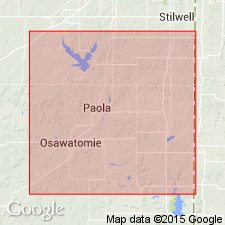
- Usage in publication:
-
- Cave limestone
- Modifications:
-
- Original reference
- AAPG geologic province:
-
- Forest City basin
Summary:
Pg. 7. Cave limestone. Hard, brittle, brown, gray, and drab limestone, 20 to 30 feet thick, forming bed No. 9 in Coal Measures of Miami County, eastern Kansas. Occurs in beds of medium thickness, separated into fragments by vertical fractures. Overlain by 15 to 18 feet of sandstone underlain by Einstine sandstone. Age is Pennsylvanian.
Apparently named from occurrence in it of many caves and crevices from which bold springs usually flow, Miami Co., eastern KS.
Source: US geologic names lexicon (USGS Bull. 896, p. 377).

- Usage in publication:
-
- Cave limestone†
- Modifications:
-
- Abandoned
- AAPG geologic province:
-
- Forest City basin
Summary:
Pg. 118. Field work has shown that excepting at Lecompton (where the beds belong to a very much higher horizon) the †Cave limestone of Swallow is Wyandotte limestone.
Source: US geologic names lexicon (USGS Bull. 896, p. 377); GNC KS-NE Pennsylvanian Corr. Chart, sheet 2, Oct. 1936.
For more information, please contact Nancy Stamm, Geologic Names Committee Secretary.
Asterisk (*) indicates published by U.S. Geological Survey authors.
"No current usage" (†) implies that a name has been abandoned or has fallen into disuse. Former usage and, if known, replacement name given in parentheses ( ).
Slash (/) indicates name conflicts with nomenclatural guidelines (CSN, 1933; ACSN, 1961, 1970; NACSN, 1983, 2005, 2021). May be explained within brackets ([ ]).

